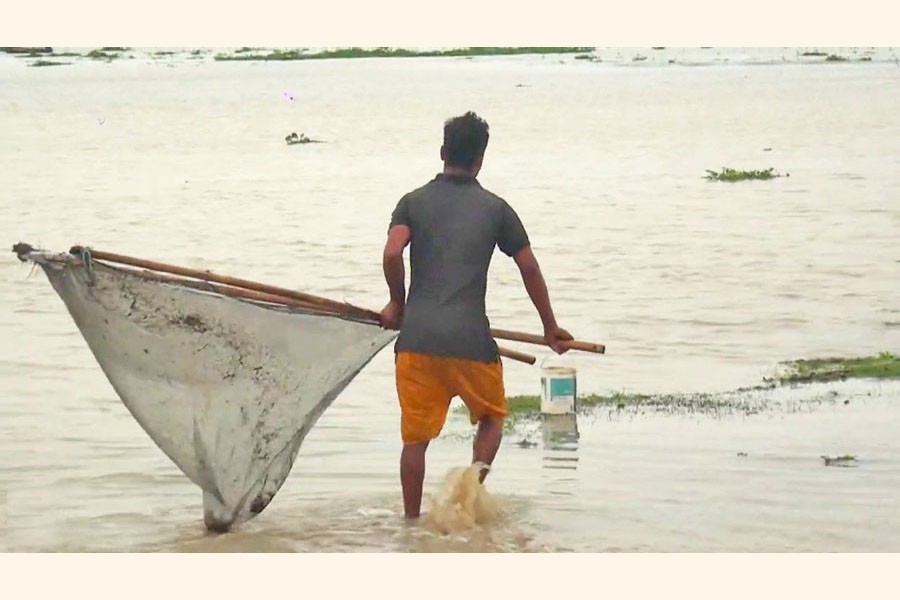For a small country like Bangladesh to rank 3rd in the world for producing inland fish is an enviable feat. Not long ago, many indigenous fish species were on the verge of extinction. But different methods of culturing those in controlled conditions developed here have brought the more popular among those back. The response from the fisheries department to the critically low production of fish has been exceptionally vigorous and to the point. Thus, an average Bangladesh citizen today consumes 62.58 grams of fish daily as against the requirement of 60 grams.
If this is an achievement for great celebration, the memory of catching wild fish during the four months starting from Ashad to Aswin before the 90's can take one on an enchanting journey. This happened to people living in plain lands that experienced regular inundation every year. Today's young generation cannot even imagine the time when only two ----and in some low-lying areas even one ---crops were grown. Aus and Aman paddy were sown not planted and the harvesting times were Shrabon and Agrahayan respectively.
In Ashad the rivers swelled and water flowed from their tributaries and canals to hinterlands down the plain basin. It was a sight to behold when water came creeping and flooding the perched lands. There was no system of irrigation at all. With the onrush of water came fish of local varieties. The water table continued to rise inch by inch. At some point the path between two village homesteads came under water. It was pure delight to see the crystal clear water and the delight increased several times more by the arrival of large flocks of fish such as puti, khalse, chanda and boicha (smaller version of khalse). Amateur fish hunters lay in wait with what is called a khepla or jhaki jal (net flung deftly to spread in a round shape over the targeted flock of fish). The silvery or greenish reflections visible within the net were so enjoyable! One such net casting would have been enough for a moderately large family's whole-day need.
The other delightful experience was when water was allowed to enter a pond through a narrow channel which otherwise would be left closed by bamboo fences or even a barricade of heaps of earthen mound. As the water ran into the pond, it produced a temporary sight of a waterfall. Fish in the pond could sense the fresh water and started dancing and jumping. A bamboo trap kept dexterously slamming the two sides of the channel closed would be full of all kinds of fish eager to get out of the pond.
But perhaps the most enchanting fish hunting device was the contraption of a net that is manoeuvred instantly to capture large fish such as Rui, Katla and other big fish. This net is called bhuti jal which is an inland edition of the hilsha net with the only difference that this net uses a thin bamboo pole instead of a rope to close the gaping arms together. Also the set of strings attached to the net's upper layer that carries the vibration produced when hilsha dashes against the net 30-40 feet underwater is irrelevant here. Instead, the catcher looks down through the transparent water to keep watch of the gate left open in the middle of what is called a 'gahra', a barricade of fences constructed with bamboo files or even date leaves placed side by side and erected at a convenient place of natural water flow. Usually the depth of water would be 10 to 15 feet and the catcher would either lie in wait on a platform specially made for the purpose or on boat motionlessly. Sometimes a shoal of large fish would come sprightly and entered the net. The catcher has to know when he has to close the bamboo arms that came together when pulled up.
Sometimes it was a long wait for a fish to enter the net. Even a few clever fish would come close to the gate, closely surveyed the place and then slowly retreated. In the peak season, though, there were records of catching more than a hundred rui fish in one pull of the net. To watch fish entering the net in a large body was thrilling. Sometimes the sight of a huge flock was so spell-binding that the man in wait completely forgot to pull up his net in time. To an amateur fish hunter, capturing a large fish may be a life-time experience. The seasoned catchers, though, had far greater exploits under their belt.
There are various other methods of fishing. But apart from a long net more like a shari but longer than it used for catching 'koi', mini, shing, taki etcetera; the others need different types of expertise. So those are not for amateur fish catchers. Gone are those days when fishing turned out to be a passion and an enchanting experience.

- Friday, 19 April 2024 |
- Today's FE |
- e-Paper |
- Beta Website

